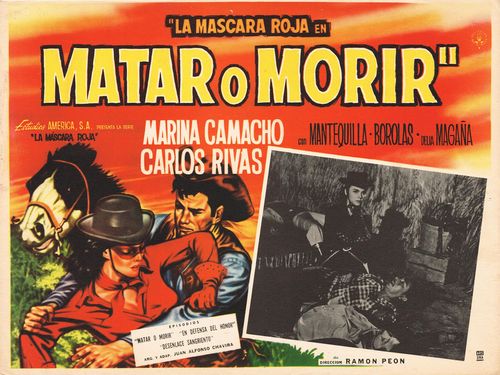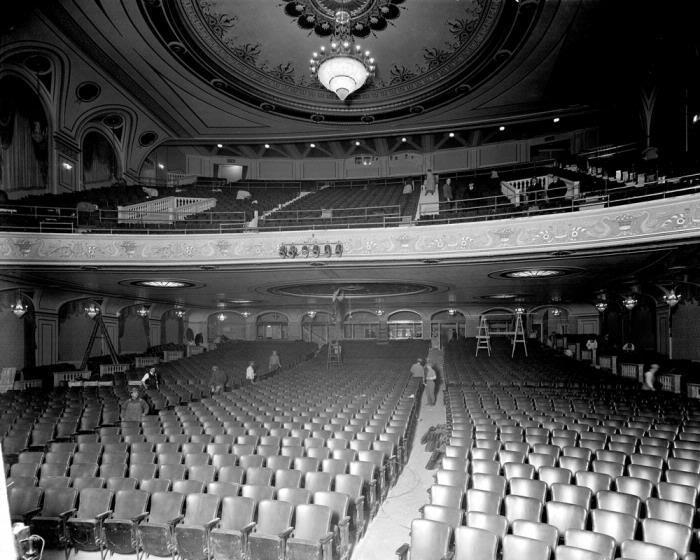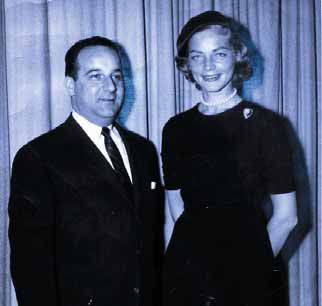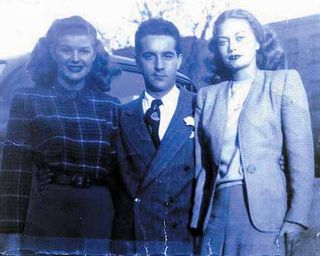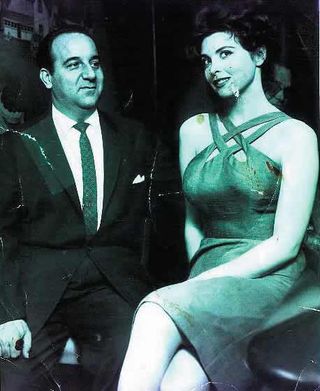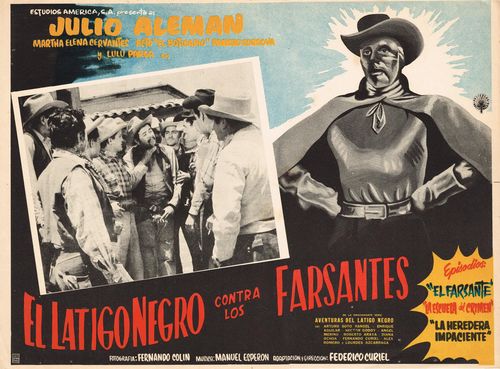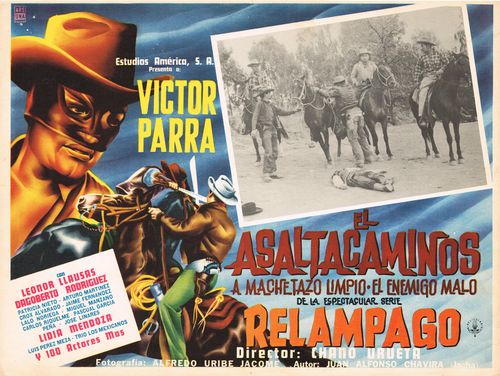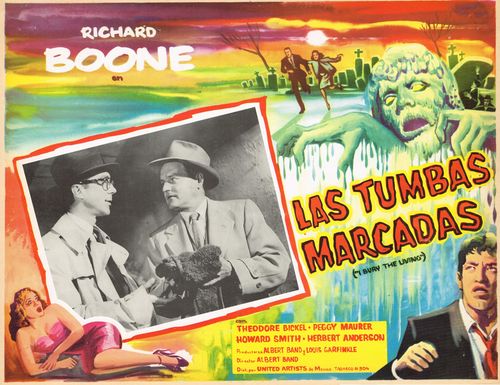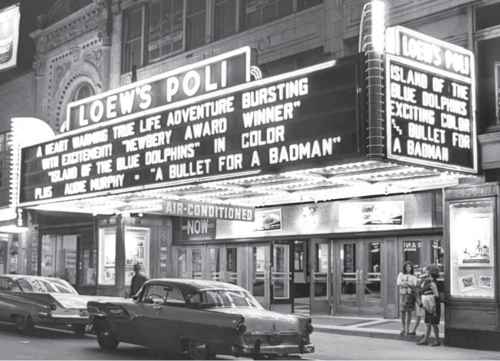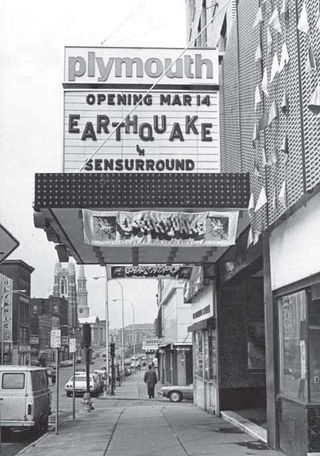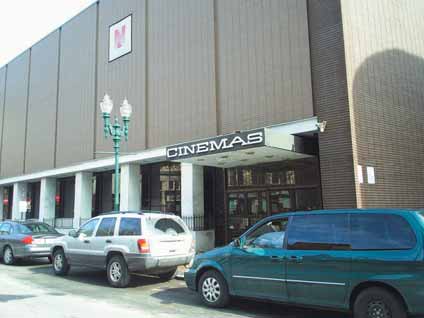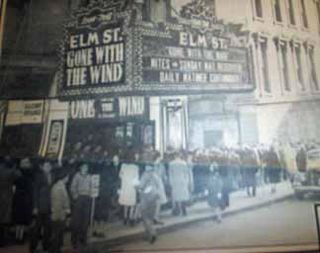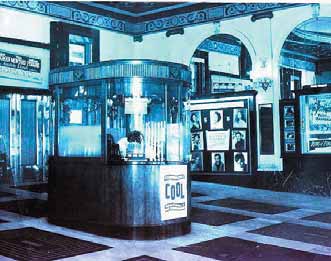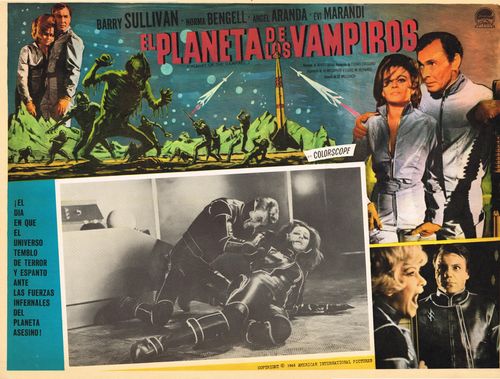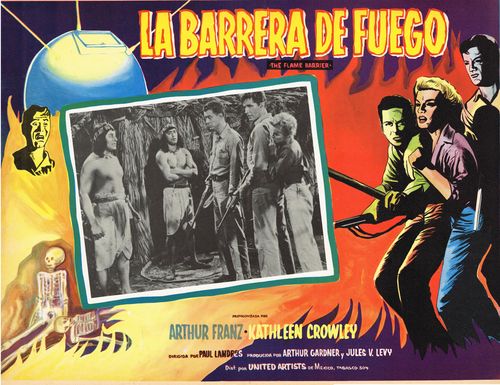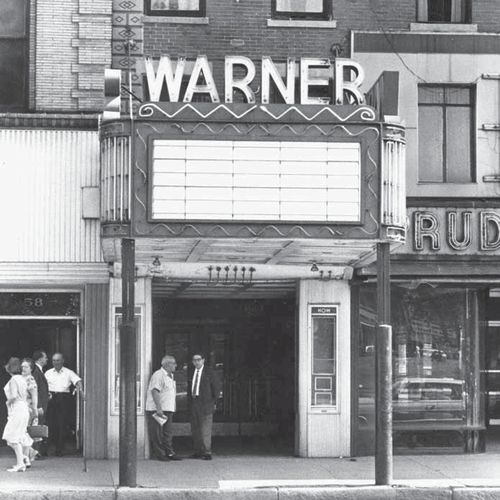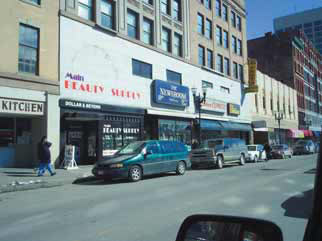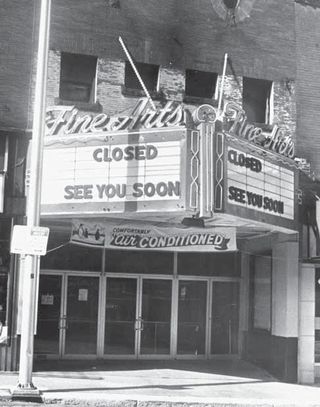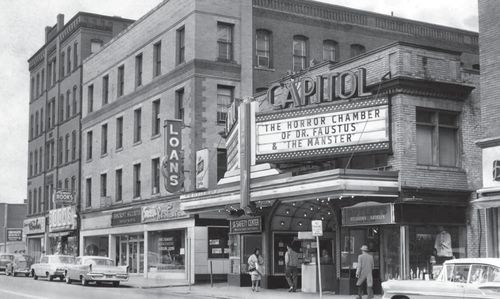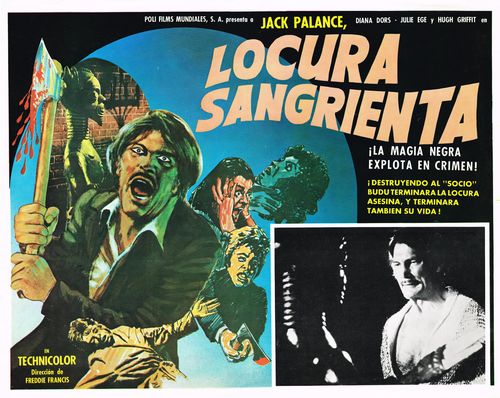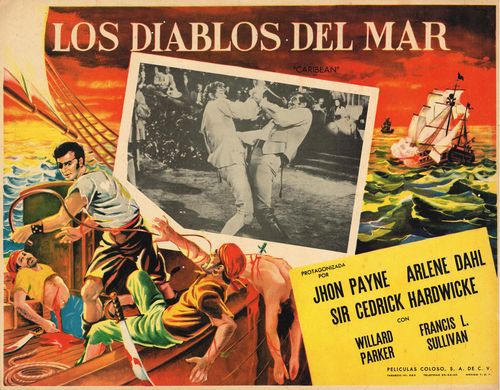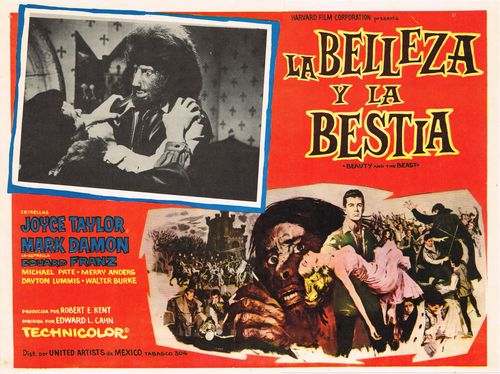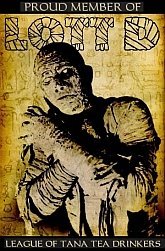From Zombos' Closet
From Zombos' Closet comes a classy and trashy collection of popular culture artifacts for those who love the terrors and treats found in movies, books, and Halloween.
June 24, 2013
Mexican Lobby Card:
La Mascara Roja En Matar o Morir
Posted at 03:00 PM in Azteca/Mexican Lobby Cards | Permalink | Comments (0)
They Tore Down Paradise...
And the Movie Theaters of Our Dreams
Part 4
With the kind permission of Brian Bukantis (Arena Publishing) and the author Dr. Vollin (Freddie Poe), I'm happy to be able to reprint Dr. V's article, They Tore Down Paradise...And Put Up a Parking Lot, which originally appeared in the May issue of Movie Collector's World, No. 683, 2005. Here's Part 4.
Did you know that in 1957 90 million patrons a week attended the movies.
In 1967 that number dwindled to 2 million.
OTHER WORCESTER THEATERS
In 1942 there were more than 16 theaters operating in Worcester: these included the Poli Palace; the Plymouth; the Strand; the Capitol; the Worcester Theater on Exchange St; the Pleasant; the Crystal on Trumbell Street; the Elm Street; the Regent on Elm Street; the Family; the Rialto; the Bijou on Millbury Street; the Court on Lincoln Square; the Vernon; the Columbia; the Royal, and the Gem. By 1966, only the Loew’s- Poli, the Warner, the Fine Arts, and the Phillips were still in operation. The rest had closed for good or for renovation. In 1977, only three remained open in the downtown area: the Showcase (Poli); the Paris (Capitol); and the Fine Arts (Pleasant Street Theater),with the latter showing foreign art films. Today, only the two “art” houses are in operation and possibly not for long.
Long gone are the days when you walked to the local theater to look at the posters to see what movie was coming next. A movie in those days was changed about every two weeks or so, unless it was a blockbuster and was held over, in which case a movie might stay indefinitely, or until everyone had seen it at least twice. Gone are the days when for one admission you could stay all day and see the movie as many times as you like. Gone,too, are the long lines extending around the block, causing empty neighborhoods on weekends because everyone was downtown at the movies. And gone were the double features, the spook shows, cartoons, and the newsreels, along with the ushers, the giveaways, and the cheap popcorn. Long gone is the classic movie, too.
ORDINARY TALES OF THEATER MADNESS
When I was about 5 years old and not old enough to wander Front Street by myself, my father would have one of his dishwashers, George, take me to the movies. George was known around Worcester as a hustler and a con man of sorts, but not violent in any way; just a fast talking guy with a lot of stories. If George asked you to borrow a $100 bill, in about 5 minutes you’d be gladly handing it over to him, and 10 minutes later you’d be asking yourself why you just did that. If my father gave him $2 to take me to Woolworth to buy me a monster model, George would say to me “nevermind those monsters, how about some nice Matchbox cars?” because Matchbox cars were much easier to put in your pocket. George would then get to keep the $2, which bought about 6 beers back then. Well, no dastardly deed goes without some kind of retribution and George got his on more than one occasion. Which brings us to the tales I am about to tell you.
Pollyanna at the Warner
My dad gave George some money and told him to take me to the movies. If my memory serves me well, it was to see Pollyanna at the Warner Theater, so I would estimate my age at about 5 or 6 years old. On the way to the Warner George must have seen someone he was trying to avoid, so we crossed Front Street. As we passed an alleyway, out popped a man.
“Georgie boy, hey I’ve been looking for ya.”
“I can’t talk now pal, I gotta take Freddie’s son to the movies,” said George.
“This will only take a second. Come down here,” said the man, indicating the alley. This is in broad daylight mind you.
“You wait here little buddy, I’ll be right back,” George instructed.
I watched as the man led George down the alleyway, and after a few choice words started beating George about the face and head. I stood frozen with fear, watching this for as long as it took. It must have only been a few seconds but it seemed like a long time. George emerged from the alleyway holding his handkerchief (remember those? yeechh) to his bloodied face. I looked up at George and said “George? Why did that man hit you?” He looked down at me, bloodied and beaten. “Don’t worry little buddy, he was just kidding around. That’s a good friend of mine.”
We headed down Front Street to the Warner, George holding the handkerchief to his bloody face and me checking on him every step of the way, horrified.
Pinocchio at the Poli
Pinocchio is my all time favorite Disney movie, maybe because he was an Italian. It was playing the Poli Palace and I asked my Dad if he would take me to see it. My father really never took me anywhere after he bought his restaurant in 1960; rather, I had male "nannies” and George was the main one. George, while being totally devious, was also one hell of an educator and always pointed me in the right direction, despite his own shortcomings. Anyway, we headed off to the grand old Poli Palace to see Pinocchio. We got there a little early, which gave me plenty of time to ogle the posters, get some snacks, and find the best seat in the house. I always liked to sit close to the screen, not in the first row but certainly in the first 10. George always let me pick out the seats. We sat, awaiting the cartoons, when a heavy set woman wearing a Carmen Miranda-type hat sat down in front of me. I don’t think it was a fruit bowl but it was certainly a flower basket. “George. I can’t see,” I said “Don’t worry pal, she’s gonna take her hat off when the movie starts.”
The movie started but the hat never came off.
“George. I still can’t see.”
“I’ll take care of this right now little buddy.” George leaned forward in his seat. “Madame. Could you kindly remove your hat, please, my little buddy can’t see the movie.”
The woman shrugged hers shoulder and made some kind of inaudible sound. “George. I still can’t see.” George tapped the woman on the shoulder a second time. “Madame. Kindly remove your hat. My pal can’t see the screen. I’m sure the movie means more to him than it does to you.”
She shrugged forward again, uttering the same groan. Steadfastly refusing to remove her hat.
“George, I can’t see. Can we move?” By now I was willing to sit elsewhere.
“We are not moving little buddy, we were here first. You only get three strikes in baseball and then you’re out of the old ball game. I’ve asked twice like a gentleman and now I have to take drastic action.” George leaned forward again. "Madame! I’ve asked you twice like a gentlemen to kindly remove your hat. My friend cannot see the screen! Three strikes and your out of the old ball game!”
Still the woman ignored George’s demand. He jumped out of his seat, ripped the hat off the lady’s head, and threw it like a frisbee across the Palace floor. It landed somewhere in the orchestra pit. The lady sprung from the chair, screaming bloody murder at the top of her lungs. Everyone in the theater was now staring at us. Within seconds the manager (Johnny Dee) came to see what the commotion was. Naturally, George knew the manager and we got moved to a different section instead of thrown out. I swear this is a true story, as I wouldn't want my nose growing any longer than it is. Thanks for everything George. Rest in peace, pal.
JOHN DIBENEDETTO - MANAGER - POLI PALACE - 1942 TO 1979
John DiBenedetto was born in New Haven Connecticut on September 28th , 1921. In the mid 1930s, as a teenager, John was working at the Armstrong Tile Company in West Haven. He soon came to realize that factory work was not only hard labor, it was also dirty, but the country was recovering from the depression and decent paying jobs were hard to get. John started to think about what else he could do for work.
It was around this time he began his career in the movie theater industry, greatly influenced by his brother’s friend who was a theater manager in the Loew-Poli chain. When John would go to the movies, he would see this young man, neatly dressed in suit and tie, cordially greeting the patrons in the lobby, which, in those days, was an integral part of the job. This scenario impressed young John and he applied for a job as an usher.
In 1939, after serving his apprenticeship, John received a promotion to assistant manager and was placed at a Bridgeport Loew-Poli theater. He had found his niche. In 1940 he was offered a chance to advance to a managerial position in the Loew-Poli chain, but he would have to pack his bags and relocate to Columbus Ohio. John did one year in Columbus as manager, but he missed his family and longed to be back in New England. In 1942, the Loew-Poli chain then offered John a new position managing the Loew-Poli Palace in Worcester, a position he would hold for the next 37 years of his life.
John would stay on as manager of the Palace until 1979, even though the theater was sold to Redstone National Amusements in 1966. Affectionately known to many Worcesterites over the past four decades as Johnny Dee, his reputation and popularity are evident through searching old newspaper files and library archives. I was surprised to see how many times John’s picture was in the newspaper and how much weight John’s word carried around the Worcester movie scene. Johnny Dee was often pictured rubbing elbows with the stars and other Worcester notables.
Here is an excerpt from the Worcester Telegram And Gazette quoting Thomas Meehan (later went on to be a big time politician in Providence, Rhode Island), who was a theater manager in Worcester from 1912 to 1932:
Johnny Dee has a great reputation in showbiz. John is the type of guy who would have made it big in the old theater days (pertaining to the Vaudeville era); he can take responsibility, he shows good judgement and great showmanship, and he knows the people in his community. John has a great reputation across the country, he’s a good man.
This was just one of the many nice things said about Johnny Dee. Naturally, after meeting him, I was eager to hear stories about the good old days, the people he had met, did he save any memorabilia from the Poli?, and especially, what he thought of today's movies. John is still as gracious and sharp as he’s ever been as he told me the things I was anxious to know.
First, I was eager to know what Johnny Dee thought about today's movies. He admitted to me that he had not been to the movies in years. The last time was to take his grandchildren, and that was some years back. He said he would rather watch the old classics on Turner. I couldn’t have agreed with him more. I seldom go to the movies myself.
Next, I wanted to hear about any movie stars that John might have met over the years. I was in for quite a surprise. John had met Esther Williams, Glenn Miller, William Holden, Anthony Quinn, Aldo Ray, Robert Taylor, Richard Widmark, Cary Grant, Kirk Douglas, Robert Wagner, Jayne Mansfi eld, Rosemary LaPlanche (the Devil Bats Daughter herself), Macdonald Carey, Tina Louise, Al Pacino, Debbie Reynolds, Denise Darcell, Elaine Stewart, Lauren Bacall, Ann Blythe, Bob Hope, and many others.
I asked John “Who was the most impressive movie star you ever met?”
Posted at 09:42 AM in Reflections | Permalink | Comments (0)
June 21, 2013
Mexican Lobby Card:
El Latigo Negro Contra Los Farsantes
Posted at 11:58 AM in Azteca/Mexican Lobby Cards | Permalink | Comments (0)
Mexican Lobby Card: El Asaltacaminos
Posted at 12:58 AM in Azteca/Mexican Lobby Cards | Permalink | Comments (0)
June 19, 2013
Mexican Lobby Card: I Bury the Living
Posted at 08:00 PM in Azteca/Mexican Lobby Cards | Permalink | Comments (0)
June 17, 2013
They Tore Down Paradise...
And the Movie Theaters of Our Dreams
Part 3
With the kind permission of Brian Bukantis (Arena Publishing) and the author Dr. Vollin (Freddie Poe), I'm happy to be able to reprint Dr. V's article, They Tore Down Paradise...And Put Up a Parking Lot, which originally appeared in the May issue of Movie Collector's World, No. 683, 2005. Here's Part 3.
THE PARK - Corner of Park Ave and Webster Square - Seating Capacity 750
Not to be confused with the Park Theater located on Front Street, this theater sat at the end of Main Street, on the outskirts of downtown. After a 22 year run as the Park, it was the first theater in this area to be bought by the Redstone Company. It was closed in 1961 and slated for renovation. The name was changed to Cinema One and it was the first modern movie theater in the area (circa 1963).
In the late 1990s Redstone closed all of its interests in the Worcester area and combined them in a giant 18 film megaplex theater called Showcase North located on the outskirts of Worcester. The theaters being closed were the Showcase Cinemas, Cinema One, and the White City. The original Park Theater building is now a vacant lot.
THE PLYMOUTH - 261 Main Street - Seating Capacity 2,700
The second largest movie house in Worcester was the Plymouth Theater. The Plymouth, a grand old theater heavily detailed in Egyptian architecture, made its debut in 1928. It had a huge stage and a proscenium to match. It played to both film and live acts. You could hurt your neck looking up at the ceiling. The projectionist booth sat 60 feet above stage level and boasted a 46 x 95 foot screen. In the late 1950s Boston millionaire Elias Loew purchased the Plymouth and it became known as Loew’s Plymouth Theater.
The last movie I saw at the Plymouth before it closed for renovation in 1965 was Monsters Crash The Pajama Party featuring a live spook show. When they were ripping down the old Plymouth marquee in 1966, a ghostly voice from Hollywood’s past spoke out from beneath it, reading “ Worcesters Newest And Most Modern Playhouse- Talking Pictures And Sound Films-Vitaphone”. Kind of eerie, eh? I wish I was wise enough at the time to have asked for that sign as it was just discarded.
While awaiting the completion of the renovation, the Plymouth moved its staff to the vacant Philip's Theater on Front Street. The Plymouth re-opened with its new doors in 1967, sans the old Plymouth sign. It now read E.M. Loew’s in yellow and red neon.
In 1973, E.M. Loew's closed once again due to the more modern cinemas opening up on the outskirts of Worcester. The Loew’s reopened again in 1975 featuring Earthquake in Sensurround, only to close a short time after. Earthquake was the last big rumble the Plymouth ever made as a movie theater.
The Loew's went through another renovation once more, ripping out the movie screen and changing the format to a rock club venue. This was pretty cool at the time, since I personally was in to the rock scene in the 1970s. I got to see artists and acts that I probably never would have gotten a chance to see elsewhere.
At Loew’s I got to hear Eric Burdon, Alvin Lee, B.B. King, Muddy Waters, John Kay & Steppenwolf, The Outlaws, The B-52s, and I got the catering contract (via my father’s Italian restaurant) for Frank Zappa’s gig. Zappa wanted one tray of veal cutlets, one tray of veal parmigiana and one tray of pasta.
No longer owned by the Loew family, the building that housed the Plymouth Theater still stands on its original site and is now a night club called The Palladium. Thrilling.
THE FAMILY - 156 Front Street- Seating Capacity - 1,000
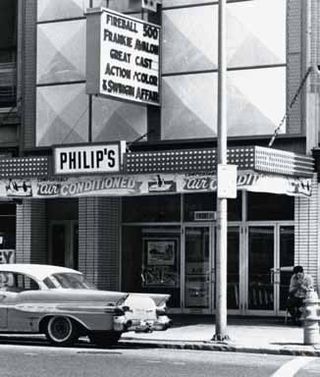 Originally called the Majestic, then later the Family, the once famous Front Street theater closed in the late 1950s and reopened in 1964 as the Philip's, also part of the E.M. Loew chain. The Philip's was located just across the street from my father’s restaurant and bar. When the Philip's reopened for business, the seating capacity had been reduced from 1,000 to 450. This was due to removing the first 12 rows of seats and the complete balcony. I saw Fireball 500 and Hot Rods To Hell there in the mid-1960s.
Originally called the Majestic, then later the Family, the once famous Front Street theater closed in the late 1950s and reopened in 1964 as the Philip's, also part of the E.M. Loew chain. The Philip's was located just across the street from my father’s restaurant and bar. When the Philip's reopened for business, the seating capacity had been reduced from 1,000 to 450. This was due to removing the first 12 rows of seats and the complete balcony. I saw Fireball 500 and Hot Rods To Hell there in the mid-1960s.
Rather than have me hanging around the bar all day listening to drunks or sitting in the booth building Aurora monster models, getting glue and paint on his tabletops, my father would give me a dollar and send me off to the movies. This is how I became a movie fanatic. Being just a stone’s throw from five or six movie theaters, I spent the better part of the 1960’s in these “old dark houses”.
In the late 1960s, the Phillips Theater, like my father’s restaurant, became the hideous victim of a massive redevelopment. The city decided to tear down Front Street and erect a Galleria that would supposedly boost the city’s wealth and prosperity. It broke my heart to see Front Street torn down. I was always against it. Of course, who was I? I was only about 12 at the time and my opinion didn't carry much weight.
This was the beginning of the end for downtown Worcester and the movie theater palaces as I knew them. Today, in 2005, thirty years later, the city has finally come to the realization that the Galleria, now called the Worcester Common Fashion Outlets, was a mistake of giant proportion and are now ripping it down and restoring Front Street back to its original state.
I wonder, do you think the neighborhood movie theater will ever come back?
THE ELM - Corner of Elm and Main Streets - Seating Capacity 2,200
This is another historic theater that served as the inspiration for this article. The Elm was one of the classiest movie houses of its day, showing films like Gone With The Wind to sellout audiences in 1939. Archive photos show patrons lined up on Elm Street, extending around the corner all the way down Main Street, waiting to enter. Bob Hope once played the Elm as an unknown vaudevillian.
The Elm opened in 1912 with Silvester Poli in attendance, and continued entertaining movie goers until 1959, when it closed forever. The Elm, along with the Poli Palace and the Plaza, was originally owned by Sylvester Poli of New Haven Connecticut. In the late 1920s Poli sold his theater chain to Fox, and then Fox sold it to Loew’s of New York, an MGM subsidiary, who changed the name to Loew's - Poli. While he was no longer an owner, Poli's name was retained on the marquee by terms of the sales agreement.
Poli received 30 million dollars for his theaters, not a bad amount of money in the depression era. At one time, Poli owned 18 theaters in Massachusetts and Connecticut, three of which were in Worcester, making him the top theater man in New England. His Plaza theater, located across from City Hall, closed in 1941 to become the site of F.W. Woolworth's 5&10.
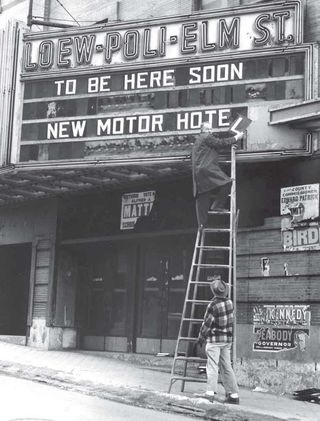 In 1961, the city planned to level the old Elm St. Theater to make way for a new motor hotel. Motor hotel was a fancy 1950s name for a parking garage. Why would you destroy a historical landmark to construct a parking lot? A real hotel maybe, but a motor hotel? The demolition crew got underway and quickly tore down the Elm. Silvester Poli, who died in 1937, would have been rolling in his grave if he had seen what Worcester did to his famed Elm St. Theater. After the demolition, the actual garage structure never materialized and the site is now a parking lot, holding a mere 15 cars at best.
In 1961, the city planned to level the old Elm St. Theater to make way for a new motor hotel. Motor hotel was a fancy 1950s name for a parking garage. Why would you destroy a historical landmark to construct a parking lot? A real hotel maybe, but a motor hotel? The demolition crew got underway and quickly tore down the Elm. Silvester Poli, who died in 1937, would have been rolling in his grave if he had seen what Worcester did to his famed Elm St. Theater. After the demolition, the actual garage structure never materialized and the site is now a parking lot, holding a mere 15 cars at best.
I have lived in Worcester for almost 50 years. I never could stomach Worcester logic. It’s nauseating. Shame on me for never leaving this barren, god-forsaken place. They tore down a movie theater paradise to put up a parking lot.
THE POLI PALACE - Franklin Square/Federal Square - Seating Capacity 3,200My personal all-time favorite theater in Worcester was the Poli Palace, also known as Loew’s- Poli Palace.
Originally the home of the Franklin Square Theater and later the Grand, Poli purchased the building in the early 1920s with the intent of creating another one of his movie palaces. An Italian immigrant, he came to America in 1881 at the age of 23 and got his start in the business working at the Eden Muse theater in New York. Poli became famous for his grandiose-styled theaters. Richly decorated in Italian and old world architecture, the Palace featured bronze-framed doors, plush carpets, cut glass mirrors, crystal chandeliers, marble pillars and staircases, giant velvet drapery, and a massive and highly ornate domed ceiling. Poli's intent was to make the Palace the biggest and best movie house Worcester had ever seen. And that he did.
On November 15th 1926, the Poli Palace had its grand opening, playing to a standing room only crowd of 3,500. The opening night attractions featured George Coo’s Petite Revue which was a five act Vaudeville bill, followed by Adolphe Menjou starring in The Ace Of Cads accompanied by Cecil Bailey on the Palace’s monster-sized organ, and a 10 piece orchestra led by Fred Valva.
Opening night was a great success and the rest is history. All the big stars graced the Palace, both on the stage and on the screen. Milton Berle played there as did George Burns and Gracie Allen. Palace regulars included Trixie Friganza, Doc Rockwell and George Price, the Fred Waring Orchestra, Ina Ray Hutton and her all girl band, Pegleg Bates, Pat Rooney, Eva Tanguay, Hildegarde, Dorothy Lamour, Gilda Gray, and Belle Baker.
By 1939 Loew’s had bought the Poli theater chain and the Poli Palace shared its name with the Loew Company (not to be confused with Elias Loew of Boston, who later owned the Plymouth and the Fine Arts theaters). The old Poli Palace sign came down and the new Loew’s - Poli went up. It was still fondly referred to as the Palace until 1967 when the Loew family sold the theater to the Redstone Company (now National Amusements) for renovation. Redstone, which already owned the ahead-of its-time Cinema One at Webster Square (formerly the Park) was buying up Worcester theaters and modernizing them. In 1968, the totally revamped Palace opened as the Showcase Cinemas, now featuring 2 screens on split levels.
The Showcase premiered with a re-release of Gone With The Wind and William Castle’s Rosemary’s Baby playing to a mere 1,700: a far cry from Poli’s grand opening of 3,700 some 42 years earlier.
I remember running down to the Showcase after school one afternoon in 1973 to see the re-release of The House Of Wax In 3-D, the last great horror movie I saw in that theater, and The Exorcist. The “last picture show” for the Showcase Cinemas was held in 1998, when Redstone closed their downtown theaters and moved to the megaplex format.
The Poli Palace was where I fell in love with the movie poster format of advertising. No theater that I can remember boasted more poster art than the Palace. They put everything up: the one sheets, the lobby cards, the inserts, door panels, banners, and stills. They had all kinds of display frames in the outdoor lobby. Any time I left my father's restaurant, I was supposed to stay on Front Street, but I would often sneak across the Worcester Common and head down Main Street to the Palace, to stare in awe at the lobby posters, which are now a long lost art form.
Long live the Poli Palace!
Posted at 07:58 PM in Reflections | Permalink | Comments (0)
Planet of the Vampires (1965)
Mexican Lobby Card
Posted at 12:50 PM in Azteca/Mexican Lobby Cards | Permalink | Comments (0)
Mexican Lobby Card: The Flame Barrier
Posted at 12:37 PM in Azteca/Mexican Lobby Cards | Permalink | Comments (0)
June 07, 2013
They Tore Down Paradise...
And the Movie Theaters of Our Dreams
Part 2
With the kind permission of Brian Bukantis (Arena Publishing) and the author Dr. Vollin (Freddie Poe), I'm happy to be able to reprint Dr. V's article, They Tore Down Paradise...And Put Up a Parking Lot, which originally appeared in the May issue of Movie Collector's World, No. 683, 2005. Here's Part 2.
My first visit was to the newspaper clippings files at the Worcester Public Library. I spent six hours perusing articles pertaining to the old movie houses, but because the newsprint paper was so old and faded, making copies was a waste of good money. I could have bought a nice lobby card with the money I spent on worthless, unreadable scans. That led me to inquire about the photo archives contained in The Worcester Telegram building.
Not everyone is allowed to rummage through the city newspaper's photo archives, so first I had to be cleared by the managing editor as to what these photos were to be used for. I informed the nice lady that I would not be making money off them, and that the Worcester Telegram would be given full credit for any photos I may use from their archives. She then told me I would have to pay “x amount of dollars per photo” whether they were 8x10s or transfers to a disc. Naturally, with no other recourse, I agreed. After that, I would have to meet with the archive librarian so he could locate the photos I needed, and then meet with the photo lab crew to have the prints made. With this task checked off, I proceeded to the next ones. I would have to go downtown and photograph the existing theaters and the sites of the defunct ones. Plus, I had my morning coffee meetings with Johnny DiBenedetto, to add his expertise on the subject. But this article for Movie Collector's World was to be a labor of love, so I dove in.
Taking my gig to the streets of Worcester did not go without incident. While photographing the building where the Warner Theatre once stood, I was approached by a local wannabe gang-banger. He stood there eyeballing me. I stared back at him. Finally he spoke: “Yo, I hope you’re not takin’ my picture Yo?” “Why? Who are you? I asked. “None of your business. Just don’t be taking my picture yo...” “Don’t worry, no one’s taking your picture. You ain't no headliner,” I countered.
When he figured out he was not scaring me nor was he going to confiscate my camera he departed, periodically glancing back over his shoulder. The fact that I’m 6-foot and 200 pounds, with a “go ahead make my day” attitude, may also have been a deciding factor for him to go on his merry gang-banging way. Smart move, Yo.
I then followed up on an appointment to visit the Worcester Telegram Photo Library. When I arrived I was met by the head librarian, who led me to a room filled with filing cabinets. He had already located the files I was looking for. He pushed them across the desk and told me to take my time. It didn't take too long to find the examples I was looking for, but I couldn't help but look at every photo in the stack. I would have liked to have bought one copy of each for nostalgia’s sake, but after reading their price list, I realized that they were not there to be in the photo business. Their price list was probably made up for the mother who wanted to buy a photo of her son hitting the winning home run in a little league game. The photos I wanted came to $160.00, which was a bit much for a contribution article, so I opted for putting the photos to a disc for a lot less. While I was paying for them, it hit me. I’m what they call a “retirw.” That’s a writer who pays to write instead of getting paid. It’s all backwards but I guess it’s a lofty position to be in. Right?
A Rich History
Naturally, the first theatres in Worcester were not erected as movie houses. In 1857, William Piper built Worcester’s first playhouse located at 10-14 Front Street, across from Worcester’s City Hall. It was originally called Piper’s Worcester Theatre and later, the Athenaeum, the Musee, the Front Street Opera House, and the Park.
In 1863, the stage at Piper’s Theatre featured Shakespeare’s King Richard the Third, starring none other than actor John Wilkes Booth in the leading role. Well, we all know what he did at Ford’s Theatre 2 years later in 1865. This building still stands but wears a different face (shown at left).After the turn of the century most all of the old playhouses in Worcester, and there were many, unknowingly were about to morph into something that would change the entertainment world forever. Renovations would be made to accommodate the coming of the motion picture; screens and projection booths were installed and many of the theaters changed names. Still, for some time to come, the motion picture shared the stage with Vaudeville acts, musical revues and plays. But by the time the silent movies went to sound, live acts started to diminish and the movie theater reigned supreme.
Worcester Theatres
THE PLEASANT STREET PLAYHOUSE -17 Pleasant Street - Seating Capacity 1,300
Built in 1891, the Pleasant Street Playhouse, originally a live act venue, changed it’s name to The Pleasant Street Theater with the coming of the silent film. In the 1940’s, with the movie industry in full swing, the theatre changed it’s name to The Olympia Theater, and by 1956 was renamed the Fine Arts when it was sold to Boston millionaire E. M. Loew (Elias M. Loew). It opened with Diabolique starring Simone Signoret.
In the late 1960s, the Fine Arts started showing risque foreign films or “art films” as they were commonly referred to. It remained the Fine Arts until 1984 when it again changed ownership. Today this historic building still stands at it’s original site and is called Art Theater, which now shows pornographic films. Sadly, this is one of the last movie theatres still standing in downtown Worcester. I have not been inside the Fine Arts since I saw Flipper there in 1963. I don’t think I’ll be checking it out any time in the near future.
THE RIALTO- 33/45 Millbury Street - Seating Capacity 1,280
The Rialto was way before my time, having been stablished in 1918 by the Fedeli Brothers, Fred and Joe. It was an escape from reality for many depression-era Worcester residents. A ten-cent movie house, it gave away free dinnerware to all it’s patrons. Worcesterites of the era ate many a meal off the Rialto’s free dinnerware. I believe this was an ongoing practice in other theaters as well.
At the Rialto, you could catch a Pathe or Movietone newsreel, along with a serial chapter from Flash Gordon or Tarzan, followed by a cartoon and a feature film, of perhaps Tom Mix or Hop-A-Long Cassidy. The Fedeli Brothers got their start in the movie business at the Bijou Theater, located just across the street. The Rialto closed it’s ancient doors in 1959 giving up part of its building to the Interstate-290 project. The remaining portion of the building burned to the ground in 1988. A new building stands on the site.
THE ROYAL- Main Street - Seating Capacity 750
Another depression-era movie house was the Royal, located next door to the Worcester Market, Worcester's first and largest super market. The Royal, like the Rialto, also featured “spectaculars” much to the enjoyment of the “knickered youths” of the neighborhood. The Royal closed it’s doors in 1955 when owner E.M. Loew gave up it’s interests after a 10year run. The block on which it stood was torn down and is now the site of the Registry Of Motor Vehicles.
THE STRAND- Front Street - Seating Capacity 1,500
Just a few doors down from where Piper opened Worcester's first theatre was the Strand, a popular 1940’s movie house, which later changed its name to the Warner Theater in the 1950s. The Warner was one of the many theaters located on Front Street, Worcester's second biggest street at the time.
I frequented the Warner often in the early 1960’s. Some of my fondest memories are from movies I saw at the Warner, like The Alamo, How The West Was Won, and my favorite Hammer double feature release Curse Of The Mummy’s Tomb and The Gorgon, complete with a monster trading stamp give-away . By the mid 1960’s the building that housed the Warner Theater, like so many others, had been slated for renovation. The building still stands today in the form of an office building.
THE CAPITOL-Franklin Street - Seating Capacity-1,500
The Capitol Theater was the only theatre on Franklin Street, which ran parallel to Front Street. It opened on Christmas day in 1926 and boasted a giant custom-made Wurlitzer organ, equipped with a device called a “toy counter” which enabled the organist to make sound effects to accompany silent era films. It also contained a feature called vox humana, which mimicked the female singing voice. The organ was originally purchased for $35,000, an astronomical amount for the day. In 1964, after sitting idle for 20 years, the organ was purchased by a local college and put back into use.
I’ll never forget seeing a great double feature at the Capitol in 1963, The Horror Chamber Of Dr. Faustus and The Manster. The last movie I saw there, while it was still called the Capitol, was William Castle’s I Know Who You Are And Saw What You Did in 1965. The Capitol closed down briefly in 1966 for renovation and reopened as the Paris Cinema in 1967, premiering with Bonnie and Clyde, which I viewed five times in one week.
One thing I remember about the Capitol was the ornate ceiling. It was painted like the heavens. It almost looked like a planetarium. You couldn’t help but to stare up at it. In the 1970s the Paris Cinema branched out into the showing of “midnight movies”. I saw many a great midnight flick at the Paris: Mark Of the Devil, Reefer Madness, Last House On The Left, A Clockwork Orange, Vanishing Point and The Performance with Mick Jagger.
If you look at the picture of the Capitol that I have provided, you will see a bookstore to the left. This is where Al Astrella (former Wormtowner, now in Santa Cruz, CA) and I would buy our back issues of Famous Monsters magazine.
In the 1980s the Paris suffered the same fate as the Fine Arts and started showing pornographic material, both “adult” and “adonis”. Just a few months ago, the Paris was raided by the Worcester Vice Squad to find live, multiple partner, sex acts going on in a second floor theater. What a shameful ending to one of Worcester's finest old movie theaters.
Posted at 03:38 PM in Reflections | Permalink | Comments (0)
Mexican Lobby Card: Craze
Posted at 02:00 PM in Azteca/Mexican Lobby Cards | Permalink | Comments (0)
Mexican Lobby Card: Caribbean
Posted at 12:00 PM in Azteca/Mexican Lobby Cards | Permalink | Comments (0)
Mexican Lobby Card: Beauty and the Beast
Posted at 10:43 AM in Azteca/Mexican Lobby Cards | Permalink | Comments (0)
Subscribe to Weekly Email for New Posts!
Go To...
Read My Book on Kindle
I Like to Talk
Categories
- Art/Animation (32)
- Authors (28)
- Azteca/Mexican Lobby Cards (779)
- Bloggers (48)
- Books (Bad) (2)
- Books (Fiction) (51)
- Books (Graphic) (33)
- Books (Non-fiction) (31)
- Comics/Manga (85)
- Convention/Event Programs (8)
- Death (13)
- Documentaries (11)
- Freaks/Geeks (5)
- Gift Ideas (12)
- Halloween (Memories) (54)
- Halloween Candy (36)
- Halloween Costume (70)
- Halloween Light-Ups (16)
- Halloween Novelty (91)
- Halloween Paper (63)
- Haunt Attractions (8)
- Horror Hosts (29)
- Kinema Archives (51)
- LOTT D (66)
- Magazine Morgue (261)
- Model Kits/Figures (10)
- Monster Laffs (10)
- Movies (Bad) (49)
- Movies (Drive-in) (31)
- Movies (Ghostly) (19)
- Movies (Gore) (9)
- Movies (Horror) (90)
- Movies (Indie) (33)
- Movies (Non-horror) (9)
- Movies (Slasher) (12)
- Music/Radio (13)
- Pictures (102)
- Pressbooks (Horror, Sci Fi, Fantasy) (666)
- Pressbooks (Non-Horror) (198)
- Reflections (58)
- Short Stories (2)
- Superheroes (9)
- Toys/Games (23)
- Trading Cards (16)
- TV/PC (28)
- Universal Monsters (21)
- Vintage Days (26)
- Wild West Weird (6)
- Zoc's Desk (9)
Significant Others
Other Others
Copyright Notice

From Zombos' Closet by John Michael Cozzoli is licensed under a Creative Commons Attribution-NonCommercial-NoDerivatives 4.0 International License.
Based on a work at http://www.zomboscloset.com.- Copyright© 2006-2023
From Zombos' Closet's fictional characters and personal blog posts are created and copyrighted by JM Cozzoli. Additional content is copyrighted by the respective contributors and owners of that content. From Zombos' Closet is a non-commercial site for the enjoyment of fans of the fantastique, the horrifying, the trashy, and the sublime.
